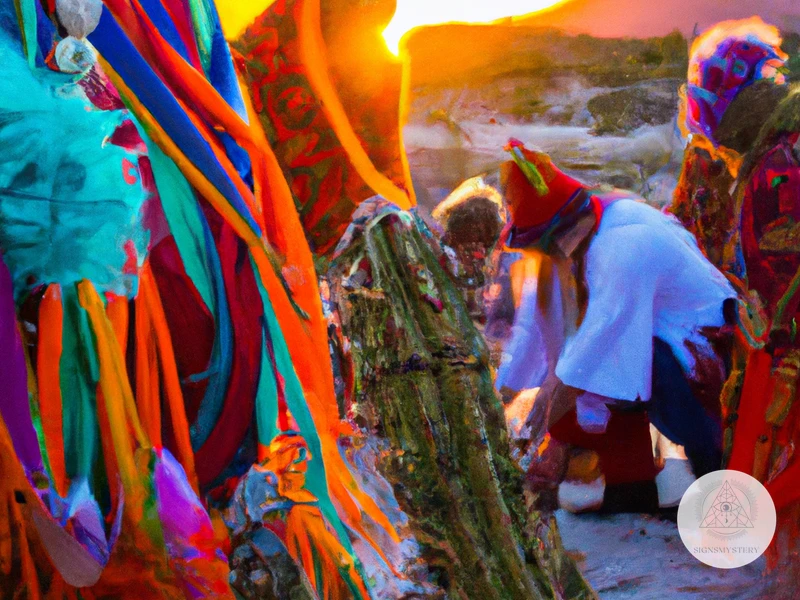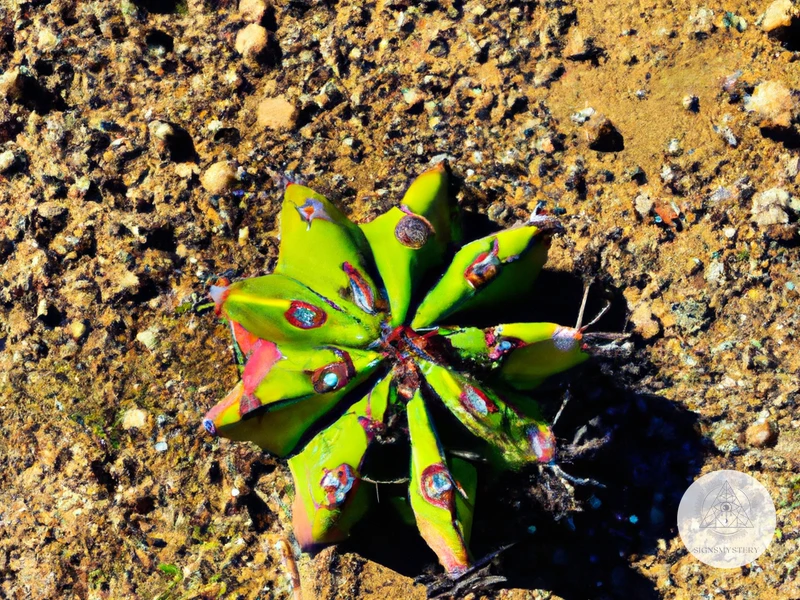Peyote, a small and unassuming cactus native to Mexico and parts of the Southwestern United States, has played a significant role in Native American spirituality for centuries. Its use in religious ceremonies and healing practices has been passed down from generation to generation, but has also faced controversy and legal restrictions. In this article, we will explore the history of peyote use in different Native American tribes, the spiritual and healing properties attributed to the cactus, the scientific research behind its effects on the human brain and body, as well as the ongoing ethical and legal debates surrounding its use. Join us on a journey into the mesmerizing world of peyote and its importance in Native American spirituality.
The History of Peyote Use in Native American Spirituality

Peyote, a small, spineless cactus native to North America, has played an integral role in Native American Spirituality for centuries. Its use in spiritual practices can be traced back at least 5,700 years, and it is believed to have originated in Mexico. Different Native American tribes have varying beliefs about peyote, but many consider it to be a sacred plant that can facilitate communication with the spirit world. Peyote meetings, also known as “peyote circles,” are an important part of Native American spirituality and allow individuals to connect with the divine. Peyote art, which often features geometric patterns and bright colors, is also closely tied to Native American spirituality and is seen as a way to visually document the peyote experience. Although peyote has a rich cultural and spiritual history, controversy surrounding its use persists today.
Peyote Use in Different Tribes
Peyote has been used for centuries as a sacrament in the religious ceremonies of various Native American tribes. The use of peyote was widespread among the tribes of the southern United States and Mexico. The most well-known users of peyote were probably the Native American Church and the Huichol people of Mexico.
The Native American Church, which was founded in the late 19th century, is a religious organization that combines traditional Native American beliefs with Christian teachings. The church regards peyote as a sacrament, and its members use it in religious ceremonies. The use of peyote in the church is protected by law, and members are allowed to use peyote even in states where it is otherwise illegal.
The use of peyote among the Huichol people of Mexico dates back to pre-Columbian times. The Huichol believe that peyote connects them with their ancestors and the spirits of nature. They use peyote in religious ceremonies to communicate with the spirits and receive guidance from them.
Other tribes that have used peyote include the Comanche, Kiowa, Navajo, and various tribes in Mexico. The way in which peyote is used varies among the tribes. Some tribes use peyote in individual vision quests, while others use it in group ceremonies. In some tribes, only certain members are allowed to use peyote, while in others it is open to all.
Despite the variations in peyote use among different tribes, it remains an important part of Native American spirituality. Its use has been protected by law in the United States since the 1970s, and it continues to be used by members of the Native American Church and other tribes.
The Importance of Peyote Meetings
Peyote meetings are an essential aspect of Native American spirituality. During these meetings, individuals consume peyote and participate in rituals that are believed to facilitate spiritual connection and healing. The peyote meeting is typically conducted in a teepee or a sweat lodge and is led by a knowledgeable individual who acts as a guide for the participants.
Peyote meetings are often viewed as a way to nurture community and strengthen bonds between individuals. This is because the meetings involve sharing experiences and thoughts, and the participants are encouraged to be supportive of each other. In this way, peyote meetings serve as a means of fostering a sense of unity and togetherness among those who attend.
Peyote meetings are considered an important tool for personal growth, as individuals are expected to confront their fears, uncertainties, and self-doubts during the rituals. This can be a transformative experience that leads to greater self-awareness and a deeper understanding of one’s place in the world.
It is worth noting that there are rituals and protocols that surround peyote meetings, and these have been passed down through generations of Native Americans. These rituals are not merely symbolic; they are an integral part of the peyote experience, and they are believed to enhance the effectiveness of the sacrament.
Peyote meetings play a crucial role in Native American spirituality, as they provide a means for individuals to connect with the divine, to foster a sense of community, and to promote personal growth. Despite being controversial and taboo in some circles, peyote meetings remain an important tradition that continues to be practiced by many Native Americans today.
The Significance of Peyote Art
Peyote art is an integral part of Native American spirituality that has been passed down through generations. The symbols and images depicted in peyote art represent the spiritual experiences of individuals who take part in the peyote ceremony. The art serves as a visual representation of the visions and insights gained during the ceremony and helps to recount the stories of the people who have experienced them.
One of the most significant aspects of peyote art is the way it speaks to the interconnectedness of all things. The art often features images of animals, plants, and natural elements, symbolizing the sacred relationship between humans and the natural world. These images serve as a reminder of the importance of respecting and nurturing the earth and all of its inhabitants.
Another common theme in peyote art is the idea of transformation and rebirth. The art often features images of spiritual beings, such as birds or butterflies, which represent the journey of the soul through life and death. These images remind people of the cyclical nature of life and the importance of embracing change and growth.
Peyote art also plays an important role in the identity and culture of Native American communities. The art is a symbol of the strength and resilience of these communities in the face of historical trauma and ongoing marginalization. Through the creation and sharing of peyote art, Native American individuals and communities can express their unique experiences and perspectives while also honoring their spiritual traditions.
The significance of peyote art lies in its ability to convey spiritual experiences, reinforce the interconnectedness of all things, and celebrate the resilience and identity of Native American communities. Through its images and symbols, peyote art preserves the wisdom and traditions of a people while also continuing to evolve and inspire new generations.
The Spiritual Properties of Peyote
Peyote has been used for spiritual purposes by Native American tribes for centuries. It is believed that peyote can help individuals connect with the spirit world and gain a deeper understanding of themselves and the universe. The use of peyote in Native American spirituality is complex and multifaceted, involving various rituals and ceremonies with specific meanings. The importance of the peyote meetings or ceremonies is emphasized for its ability to bring people together and promote a sense of community. Many people also believe that peyote has healing properties and can help with spiritual and emotional issues. The role of the shaman is crucial in peyote ceremonies as they guide individuals on their spiritual journey. Although controversial, the use of peyote continues to be a significant part of Native American spirituality and is considered a sacred plant medicine.
Peyote as a Gateway to the Spirit World
Peyote has been used for centuries by Native American tribes as a gateway to the spirit world, allowing people to connect with deities and receive guidance. The use of peyote in spiritual ceremonies, known as peyote meetings, plays a central role in many tribal communities.
The Native American Church, founded in the late 19th century, incorporates the use of peyote in their religious practices. For members of the Church, peyote is considered a sacrament and is used in prayer to connect with the divine. The experience of using peyote can be described as a journey or a vision quest, where the user is transported to another realm of consciousness.
During peyote meetings, participants sit in a circle and consume peyote, often accompanied by traditional drumming and singing. The effects of peyote typically last several hours and can include hallucinations, heightened sensory awareness, and emotional and spiritual insights.
The use of peyote as a tool for spiritual enlightenment is considered sacred by many Native American communities. The responsibility of leading peyote meetings falls on experienced practitioners, often referred to as “roadmen.” These individuals are considered spiritual leaders and have a deep understanding of the spiritual properties of peyote and its role in connecting people with the spirit world.
While the use of peyote has been controversial in some circles, its spiritual significance cannot be denied. As with any plant medicine, it is important to approach peyote with respect and reverence for its power and potential. For those seeking a deeper understanding of themselves and the universe around them, peyote can be a valuable tool on their spiritual journey.
Internal link: To learn more about other shamanic plant medicines, check out our article on Top 10 Plant Medicines Used in Shamanism.
The Healing Properties of Peyote
Peyote, the mesmerizing cactus, has been popular among Native American tribes for its spiritual properties. It is also believed to have significant healing properties. The healing properties of Peyote have been linked to the presence of several active compounds, including mescaline, which is the primary psychoactive substance in this cactus.
The primary healing properties of Peyote are mental and emotional. The cactus is believed to help individuals heal from emotional and psychological distress, including depression, anxiety, and addiction. Peyote has been known to stimulate creativity and self-reflection making it an essential part of many spiritual ceremonies.
The Native American Church, which is a religious organization that practices Peyote worship, has been known to use Peyote in healing ceremonies. In these ceremonies, participants consume Peyote to help them connect with a higher power, which is believed to be the source of all healing. During the ceremony, participants often report feeling a deep sense of inner peace and spiritual connection.
Despite its healing properties, the use of Peyote has faced legal challenges in some places. Peyote is illegal in many countries, including the United States, where it is classified as a Schedule I drug. This has caused controversy over the use of Peyote in religious ceremonies, especially among Native American communities.
Peyote’s healing properties have been known to help people with mental and emotional healing, and it’s used as part of spiritual ceremonies. The use of Peyote is considered illegal in many places, and this has caused a debate on the ethical use of the cactus. However, the healing properties of Peyote are undeniable, and it remains a potent medicine for spiritual, emotional, and mental issues experienced by individuals in Native American communities.
The Role of the Shaman in Peyote Ceremonies
The role of the shaman is fundamental in peyote ceremonies. The shaman is considered the spiritual leader of the tribe, and it is believed that he can communicate with the spirit world. During the ceremony, the shaman guides the participants to connect with the spiritual realm and provides a safe and sacred space for the participants to explore their consciousness.
Shamans are chosen by their communities based on their spiritual gifts and abilities to communicate with the spirit world. They often undergo rigorous training for several years and follow a strict diet and lifestyle to enhance their spiritual practice. They are expected to have a deep understanding of the medicinal properties of peyote, as well as the traditions and myths associated with its use.
The shaman is responsible for administering the peyote to the participants and guiding them through the ceremony. This involves leading the participants in prayer, singing sacred songs, and providing guidance during visions. The shaman may also perform healing rituals and engage in spiritual practices to help the participants release negative emotional or psychological patterns.
It is important to note that the role of the shaman is not limited to peyote ceremonies but extends to other spiritual practices within native communities. Shamans often use various other plant medicines such as ayahuasca, kambo, and San Pedro in their ceremonies. They also work with other plant medicines like tobacco, coca leaves, datura, and yopo. Each plant medicine has its unique properties and is used for specific purposes in shamanic practices.
The shaman plays a vital role in peyote ceremonies as the spiritual leader who guides the participants to connect with the spirit world. They are respected members of their communities and are chosen for their spiritual gifts, deep knowledge of peyote, and commitment to their spiritual practice. You can find more information about other plant medicines used in shamanic practices in our articles about ayahuasca, kambo, mapacho,San Pedro cactus, psilocybin mushrooms, coca leaves, datura, and yopo.
The Science Behind Peyote

The active compounds in Peyote, mainly mescaline, are responsible for the plant’s psychoactive effects. Mescaline activates serotonin receptors in the brain, leading to altered perceptions of reality. The effects of Peyote can last for up to 12 hours and include visual and auditory hallucinations, euphoria, and spiritual experiences. Studies have shown that mescaline may have therapeutic benefits for mental health, including reducing symptoms of depression and anxiety. However, the use of Peyote is also controversial, as it is a controlled substance in many countries and its consumption can be culturally inappropriate or disrespectful. Despite this controversy, the spiritual and medicinal roles of Peyote have been recognized by Native American tribes for centuries.
Active Compounds in Peyote: Mescaline.
Effects of Peyote: Altered perceptions of reality, visual and auditory hallucinations, euphoria, and spiritual experiences.
Potential Benefits of Mescaline: Therapeutic benefits for mental health, including reducing symptoms of depression and anxiety.
The Active Compounds in Peyote
Peyote, also known scientifically as Lophophora williamsii, contains several active compounds that have been studied for their effects on the human body. One of the most well-known is mescaline, which is a psychedelic compound that is responsible for the hallucinogenic effects associated with peyote use. Mescaline is a potent agonist of the serotonin 5-HT2A receptor, which is believed
Subscribe to Our Newsletter
Sign up to receive the latest news and updates.
Research has also shown that peyote contains several other compounds with potential therapeutic benefits. One of these compounds is hordenine, which is a natural stimulant that has been found to increase heart rate and blood pressure. Hordenine has also been shown to have antibiotic properties, and it may play a role in the anti-inflammatory effects of peyote.
Another active compound found in peyote is tyramine, which is a natural monoamine oxidase inhibitor. Monoamine oxidase is an enzyme that is involved in the breakdown of neurotransmitters, including dopamine, norepinephrine, and serotonin. By inhibiting the activity of this enzyme, tyramine may help to increase the levels of these neurotransmitters in the brain, leading to improved mood and energy levels.
Additionally, peyote contains several other alkaloids, including anhalonidine, anhalinine, and pellotine, which have been studied for their potential therapeutic effects. These compounds have been found to have anticonvulsant, sedative, and analgesic properties, and they may play a role in the traditional use of peyote as a medicine.
The active compounds found in peyote have the potential to provide a wide range of therapeutic benefits. While more research is needed to fully understand the effects of these compounds on the human body, the traditional use of peyote by Native American communities suggests that they may have significant spiritual and medicinal value.
The Effects of Peyote on the Brain and Body
Peyote contains a variety of alkaloids, including mescaline, which is the primary psychoactive compound responsible for the effects of peyote on the brain and body. Mescaline is structurally similar to serotonin and has a powerful effect on the brain’s serotonin receptors, causing changes in perception, mood, and thought. These effects can last for several hours and can be both intense and unpredictable.
One of the most common effects of peyote is an altered sense of perception. Users often report experiencing enhanced colors, patterns, and textures, as well as a heightened sensitivity to sound and touch. Time can also seem to slow down or speed up, and users may feel as if they are in a dream-like state.
Peyote can also affect mood and emotion, with many users experiencing feelings of euphoria or intense spirituality. However, the experience can also be unpredictable, with some users reporting feelings of anxiety, paranoia, or confusion.
In addition to its effects on perception and emotion, peyote can also have physical effects on the body. These can include increased heart rate and blood pressure, dilated pupils, and sweating. The drug can also cause nausea and vomiting, which is why many users prefer to consume peyote in a medicinal tea rather than by eating the cactus.
Despite these effects, many people continue to use peyote as a spiritual or medicinal tool. However, it is important to note that the drug can be dangerous for people with certain medical conditions or who are taking certain medications. Additionally, because peyote is a powerful hallucinogen, it should only be used under the guidance of a trained professional in a safe and controlled environment.
The Potential Benefits of Peyote for Mental Health
Many researchers have been exploring the potential therapeutic benefits of peyote for various mental health conditions. The active compounds in peyote, such as mescaline, are believed to affect the brain, particularly the serotonin system, which is involved in mood regulation.
One study published in the Journal of Clinical Psychopharmacology found that peyote may have potential as a treatment for anxiety and depression. The study looked at individuals who participated in Native American Church ceremonies where peyote was used and found a significant reduction in anxiety and depression symptoms after the ceremony.
Another study published in the Journal of Nervous and Mental Disease looked at the effects of peyote on individuals with alcohol dependence. The study found that peyote use was associated with reduced alcohol use and cravings, as well as improved mood and overall well-being.
While these preliminary studies show promise for the potential therapeutic benefits of peyote, it is important to note that further research is needed before it can be used as a mainstream treatment option. Peyote is a powerful substance and should only be used under the guidance of a trained healthcare professional.
There are concerns about the sustainability of peyote and its impact on the environment. As such, any potential therapeutic use of peyote should be balanced with efforts to protect its natural habitat and ensure responsible use.
While the potential benefits of peyote for mental health are intriguing, more research is needed to fully understand its therapeutic potential and to address concerns around sustainability and responsible use.
The Controversy Surrounding Peyote Use
The controversy surrounding peyote use is multi-faceted. On one hand, peyote use is illegal in many countries, including the United States, where the Native American Church is the only entity allowed to use peyote legally for religious purposes. This has created a rift between Native American communities and law enforcement, as the use of peyote is deeply tied to their spiritual beliefs and practices. On the other hand, there is also an ethical debate surrounding peyote use, as some argue that it is cultural appropriation for non-Native individuals to use peyote in spiritual ceremonies. The issue of cultural appropriation and the commodification of traditional practices is an important one to consider, as the exploitation of Indigenous knowledge and practices for profit has long been a problem in Western culture. The controversy surrounding peyote use requires a thoughtful and nuanced approach, one that takes into account the complex cultural, legal, and ethical dimensions of the issue.
The Legal Status of Peyote
The legal status of peyote is a complex issue. While peyote has been used in Native American spiritual practices for centuries, its use is prohibited by law in many countries. In the United States, the Native American Church is the only organization that is legally allowed to use peyote in religious ceremonies.
Here is a breakdown of the legal status of peyote in some countries:
United States: The use of peyote is prohibited under federal law, except for use by members of the Native American Church in religious ceremonies. However, some states have their own laws that provide additional protections for religious peyote use. For example, Arizona, New Mexico, and Colorado have laws that specifically protect the religious use of peyote.
Canada: Peyote is listed as a controlled substance under the Canadian Controlled Drugs and Substances Act, and its use is illegal except for medical or scientific purposes.
Mexico: While peyote is legal in Mexico, it is a controlled substance and its use is regulated.
Australia: Peyote is classified as a Schedule 9 prohibited substance under the Australian Poisons Standard, and its use is illegal.
Europe: The use of peyote is illegal in most European countries, but some countries, such as Spain and Italy, allow its use for religious purposes under certain conditions.
It is important to note that the legal status of peyote can vary by jurisdiction, and laws regarding its use may change over time. It is always best to consult with local laws and regulations before using peyote or any other substance for spiritual or medicinal purposes.
The Ethical Debate over Peyote Use
The ethical debate over peyote use is a complex issue that has been ongoing for decades. On one hand, the ritualistic use of peyote by Native American tribes has been a part of their culture and spirituality for centuries. Many argue that restricting or prohibiting the use of peyote would be a violation of their religious freedom. On the other hand, there are concerns about the potential harm that peyote use can cause, and questions over whether non-indigenous individuals should be allowed to participate in peyote ceremonies.
Proponents of Peyote Use:
- Argue that the use of peyote plays an integral role in Native American spirituality and should be protected under the First Amendment’s freedom of religion clause.
- Believe that peyote is a sacred plant that connects individuals to the spirit world and can provide healing in physical, emotional, and spiritual realms.
- Contend that prohibiting peyote use would be an unjust limitation on their cultural practices and customs.
Opponents of Peyote Use:
- Raise concerns about the potential negative effects of peyote, including hallucinations, anxiety, nausea, and even death in some cases.
- Point out that peyote contains mescaline, a Schedule I controlled substance, and its use is illegal according to federal law except in specific religious contexts.
- Question the inclusion of peyote use in non-indigenous spiritual practices and argue that it is cultural appropriation.
The ethical debate over peyote use is not likely to be resolved anytime soon. It is a complex issue that involves many different facets of society, including religion, culture, law, and ethics. As the use of peyote continues to be an important part of Native American traditions, it is crucial for all sides to engage in respectful and open dialogue to find a solution that respects both religious freedom and public safety.
Conclusion
In conclusion, Peyote holds a significant place in Native American spirituality, serving as a vehicle for communication with the spirit world and healing of the mind, body, and spirit. Its use and practice have been passed down through generations and have become an integral part of the traditions of many tribes.
However, the controversies surrounding its use and legality cannot be ignored. While some argue that the religious and cultural significance of Peyote justifies its use, others question its ethical implications and the potential for abuse and addiction.
Nevertheless, the science behind Peyote and its active compounds cannot be dismissed. Research has shown that Peyote has potential for treating mental health disorders such as depression and anxiety.
Overall, Peyote and its role in Native American spirituality and culture is a complex topic that warrants further exploration and discussion. It highlights the importance of respecting cultural traditions and beliefs while also recognizing the potential benefits and risks of psychoactive substances.
Frequently Asked Questions
What is the history of peyote use in Native American spirituality?
Peyote has been used for thousands of years by various Native American tribes for its spiritually significant properties.
What are some of the different tribes that use peyote?
Some of the tribes that use peyote in their spiritual practices include the Navajo, the Comanche, and the Huichol.
What is the role of peyote meetings?
Peyote meetings typically involve a group of people consuming peyote together in a ceremonial setting to connect with the spirit world and gain spiritual insight.
What is the significance of peyote art?
Peyote art often features colorful and intricate patterns that reflect spiritual symbolism and are used to visually represent the effects of peyote on the mind and body.
What is peyote commonly used for in the spiritual realm?
Peyote is commonly used as a gateway to the spirit world and is thought to facilitate communication with higher powers and gain spiritual insight.
What are the healing properties of peyote?
Peyote is believed to have a healing effect on both the mind and body, and has been used to treat a variety of ailments including depression, anxiety, and addiction.
What is the role of the shaman in peyote ceremonies?
The shaman is usually the leader of the peyote ceremony and is responsible for ensuring that the ceremony runs smoothly and safely, as well as guiding participants through their spiritual journey.
What are the active compounds in peyote?
The main active compounds in peyote are mescaline and other phenethylamine alkaloids that produce psychoactive effects.
What are the potential benefits of peyote for mental health?
Peyote has shown promise in helping to treat a number of mental health conditions, including depression, anxiety, and PTSD, although further research is needed.
What is the legal status of peyote?
Peyote is illegal in most countries, although it is legal for certain Native American tribes to use in their spiritual practices.










